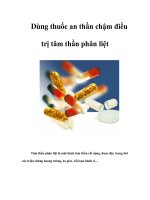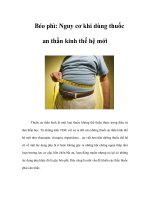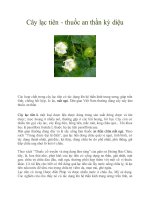Thuốc ngủ và thuốc an thần pps
Bạn đang xem bản rút gọn của tài liệu. Xem và tải ngay bản đầy đủ của tài liệu tại đây (2.8 MB, 43 trang )
The period of twenty-four
The period of twenty-four
hours formed by the regular
hours formed by the regular
revolution of our Earth is
revolution of our Earth is
apparent in all diseases It
apparent in all diseases It
is, as it were, the unit of
is, as it were, the unit of
our natural chronology.
our natural chronology.
— Christopher William
— Christopher William
Hufeland, 1796
Hufeland, 1796
SUPRACHIASMATIC NUCLEUS
BMAL1:Aryl hydrocarbon receptor nuclear translocator-like
CLOCK: Circadian Locomotor Output Cycles Kaput
Bmal (brain and muscle aryl hydrocarbon receptor nuclear translocator
(ARNT)-like)
CK1ε : casein kinase 1ε
Rhythm of waking (blue lines) and sleeping (red lines) of a volunteer
Rhythm of waking (blue lines) and sleeping (red lines) of a volunteer
in an isolation chamber with and without cues about the day-night
in an isolation chamber with and without cues about the day-night
cycle. Numbers represent the mean ± standard deviation of a complete
cycle. Numbers represent the mean ± standard deviation of a complete
waking/sleeping cycle during each period (blue triangles represent
waking/sleeping cycle during each period (blue triangles represent
times when the rectal temperature was maximum). (After
times when the rectal temperature was maximum). (After
Aschoff, 1965
Aschoff, 1965
,
,
as reproduced in Schmidt et. al., 1983.)
as reproduced in Schmidt et. al., 1983.)
CRY
CRY
(cryptochrome
(cryptochrome
), CLOCK (C) (
), CLOCK (C) (
Circadian locomotor output
Circadian locomotor output
cycles kaput
cycles kaput
), BMAL1 (B) (
), BMAL1 (B) (
brain and muscle, ARNT-like
brain and muscle, ARNT-like
), PER1
), PER1
(
(
Period1
Period1
), PER2 (
), PER2 (
Period2
Period2
), PER3 (
), PER3 (
Period3
Period3
), and
), and
vasopressin
vasopressin
prepropressophysin (VP) (
prepropressophysin (VP) (
clock controlled
clock controlled
genes
genes
; ccg
; ccg
)
)
Anatomical underpinnings of
Anatomical underpinnings of
circadian rhythms
circadian rhythms
.
.
(A)
(A)
The
The
hypothalamus
hypothalamus
, showing the location of
, showing the location of
the
the
suprachiasmatic nucleus
suprachiasmatic nucleus
(SCN), which in
(SCN), which in
mammals
mammals
is the primary “biological clock.” The
is the primary “biological clock.” The
name “suprachiasmatic” derives from the
name “suprachiasmatic” derives from the
location of the nucleus just above the
location of the nucleus just above the
optic chiasm
optic chiasm
.
.
(B)
(B)
Diagram of the pathway from the
Diagram of the pathway from the
suprachiasmatic nucleus
suprachiasmatic nucleus
to the
to the
pineal gland
pineal gland
.
.
Activation
Activation
of specific neural circuits triggers sleep and wakefulness.
of specific neural circuits triggers sleep and wakefulness.
(A)
(A)
Electrical stimulation of the
Electrical stimulation of the
cholinergic
cholinergic
neurons
neurons
near the junction of
near the junction of
pons
pons
and midbrain (the
and midbrain (the
reticular activating system
reticular activating system
) causes a sleeping cat
) causes a sleeping cat
to awaken.
to awaken.
(B)
(B)
Electrical stimulation of the
Electrical stimulation of the
thalamus
thalamus
causes an awake cat to fall
causes an awake cat to fall
asleep. Graphs show EEG recordings before and during stimulation.
asleep. Graphs show EEG recordings before and during stimulation.
Summary of subcortical/cortical interactions that generate
wakefulness and sleep. A variety of
wakefulness and sleep. A variety of
brainstem
brainstem
nuclei using
nuclei using
several different
several different
neurotransmitters
neurotransmitters
determine mental status on
determine mental status on
a continuum that ranges from deep sleep to a high level of
a continuum that ranges from deep sleep to a high level of
alertness. These nuclei, which include the
alertness. These nuclei, which include the
cholinergic
cholinergic
nuclei
nuclei
of the
of the
pons
pons
-midbrain junction, the locus coeruleus, and the
-midbrain junction, the locus coeruleus, and the
raphe nuclei
raphe nuclei
, all have widespread ascending and descending
, all have widespread ascending and descending
connections (arrows) to other regions, which explain their
connections (arrows) to other regions, which explain their
numerous effects. Curved arrows along the perimeter of the
numerous effects. Curved arrows along the perimeter of the
cortex
cortex
indicate the
indicate the
innervation
innervation
of lateral cortical regions not
of lateral cortical regions not
shown in this plane of section.
shown in this plane of section.
CHU KỲ GiẤC NGỦ
CHU KỲ GiẤC NGỦ
CHU KỲ GiẤC NGỦ
CHU KỲ GiẤC NGỦ
RAPID EYES MOVEMENT SLEEP
RAPID EYES MOVEMENT SLEEP
RAPID EYES MOVEMENT SLEEP
Physiological changes in a male volunteer
Physiological changes in a male volunteer
during the various sleep states in a typical
during the various sleep states in a typical
8-hour period of sleep (A). The duration
8-hour period of sleep (A). The duration
of REM sleep increases from 10 minutes
of REM sleep increases from 10 minutes
in the first cycle to up to 50 minutes in the
in the first cycle to up to 50 minutes in the
final cycle; note that slow-wave (stage IV)
final cycle; note that slow-wave (stage IV)
sleep is attained only in the first two
sleep is attained only in the first two
cycles. (B) The upper panels show the
cycles. (B) The upper panels show the
electro-oculogram (EOG) and the lower
electro-oculogram (EOG) and the lower
panels show changes in various muscular
panels show changes in various muscular
and autonomic functions. Movement of
and autonomic functions. Movement of
neck muscles was measured using an
neck muscles was measured using an
electromyogram (EMG). Other than the
electromyogram (EMG). Other than the
few slow eye movements approaching
few slow eye movements approaching
stage I sleep, all other eye movements
stage I sleep, all other eye movements
evident in the EOG occur in REM sleep.
evident in the EOG occur in REM sleep.
The greatest EMG activity occurs during
The greatest EMG activity occurs during
the onset of sleep and just prior to
the onset of sleep and just prior to
awakening. The heart rate (beats per
awakening. The heart rate (beats per
minute) and respiration (breaths per
minute) and respiration (breaths per
minute) slow in non-REM sleep, but
minute) slow in non-REM sleep, but
increase almost to the waking levels in
increase almost to the waking levels in
REM sleep. Finally, penile erection occurs
REM sleep. Finally, penile erection occurs
only during REM sleep. (After Schmidt et
only during REM sleep. (After Schmidt et
al., 1983.)
al., 1983.)
CÁC NHÓM THUỐC NGỦ AN THẦN HiỆN HÀNH
CÁC NHÓM THUỐC NGỦ AN THẦN HiỆN HÀNH
CÁC NHÓM THUỐC NGỦ AN THẦN HiỆN HÀNH
1.
1.
BENZODIAZEPINES: diazepam, midazolam ect…
BENZODIAZEPINES: diazepam, midazolam ect…
2.
2.
BARBITURATES: phenobarbital, ect…
BARBITURATES: phenobarbital, ect…
3.
3.
IMIDAZOPYRIDINE: zolpidem.
IMIDAZOPYRIDINE: zolpidem.
4.
4.
CYCLOPYRROLONE: zopiclone.
CYCLOPYRROLONE: zopiclone.
5.
5.
MELATONIN: hormone nội sinh đồng hành đồng hồ
MELATONIN: hormone nội sinh đồng hành đồng hồ
sinh học, điều chỉnh hành vi ẩm thực & hành vi tính
sinh học, điều chỉnh hành vi ẩm thực & hành vi tính
dục.
dục.
1.
1.
BENZODIAZEPINES: diazepam, midazolam ect…
BENZODIAZEPINES: diazepam, midazolam ect…
2.
2.
BARBITURATES: phenobarbital, ect…
BARBITURATES: phenobarbital, ect…
3.
3.
IMIDAZOPYRIDINE: zolpidem.
IMIDAZOPYRIDINE: zolpidem.
4.
4.
CYCLOPYRROLONE: zopiclone.
CYCLOPYRROLONE: zopiclone.
5.
5.
MELATONIN: hormone nội sinh đồng hành đồng hồ
MELATONIN: hormone nội sinh đồng hành đồng hồ
sinh học, điều chỉnh hành vi ẩm thực & hành vi tính
sinh học, điều chỉnh hành vi ẩm thực & hành vi tính
dục.
dục.









